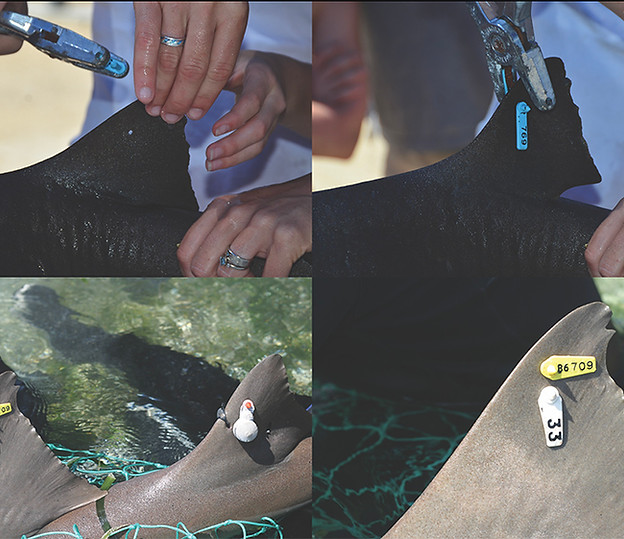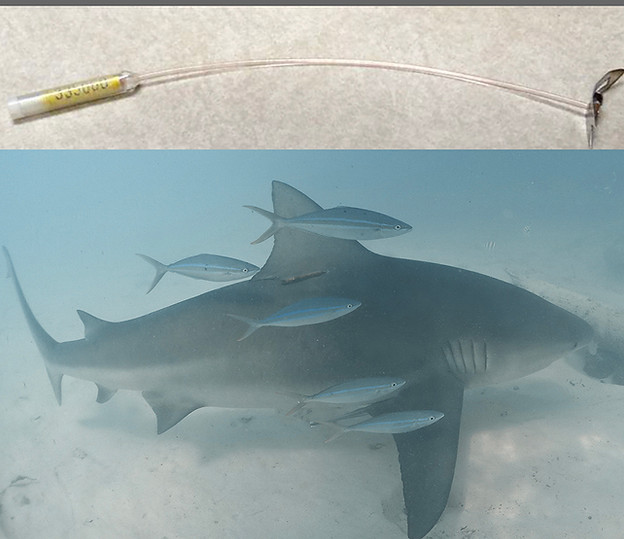Tags are used to monitor, track and locate sharks in their natural habitat. Tagging provides scientists with important information on life histories, population sizes, movement and migratory patterns, all of which are important for shark conservation. Scientists also use tags to better understand growth rates, survivorship and food webs. Additionally, tagging can be used to identify key areas for protection, such as nurseries and mating grounds, and to better understand how climate change is impacting shark movement and distribution. They can also determine areas where sharks are more likely to encounter fishing activities. All of this data is critical for shark conservation and management.
There are several types of tags which range from simple numbered tags that identify sharks individually using a unique ID code to satellite tags that allow us to track the sharks in real time. Scientists use different tags depending on what species they are studying, the size of the shark, the sex of the shark and the questions they want to answer.

PIT TAGS
(Passive Integrated Transponders)
These tags are very similar to those used by veterinarians for identifying pets and tracking livestock and zoo animals. A PIT tag is between 8-32mm long and 1-4mm in diameter. These tags consist of an electronic microchip encased in biocompatible glass, which protects the electronic components and prevents tissue irritation. PIT tags are inserted with a needle into the base of the shark's dorsal fin with a PIT tag inserter (similar to a syringe). These tags act like a lifetime bar code or social security number - if the shark is recaptured, the PIT tag reader can be used to scan the tag and acquire new data about that specific shark.

ROTO TAGS
These tags were originally made for livestock tagging but have been adapted for marine and wildlife studies. They are semi rectangular in shape and have an identification number on them. Once the shark has been caught, a Roto tag is applied with an applicator through a pre-punched hole in the shark's dorsal fin. There is an identification number on one side of the tag and a phone number or email on the reverse side. The ID and contact info are added to a database where they can be accessed and used to identify the shark anytime it's re-captured.

DART TAGS - National Marine Fisheries Service (NMFS)
M-Type dart tags consist of a dart head, one piece of mono filament, and a capsule which contains an identification number and return instructions. Each tag has a data card on which data about the shark is documented; date and location of capture plus the method of capture, size and sex of the shark. Darts are placed at the base of the shark’s dorsal fin using a scalpel to make a small incision. The tag is placed into the muscle to ensure a long lasting fit. The data cards are sent to NMFS where the information is stored. When a shark is recaptured, the information is recorded again and sent to NMFS. The previous data is then compared to the new data, such as the shark's location and size, past and present.

ACOUSTIC TAGS
Acoustic transmitters are electronic tags that send out a series of ‘pings’ every 1-3 minutes into the surrounding waters that are detected by receivers (underwater tracking systems). The receivers are small data-logging computers that are anchored on the ocean floor. As sharks swim through a network of receivers, which can detect a shark passing from 300-1000 meters away, their location, movement, and behavior patterns are recorded. These tags come in a variety of shapes and sizes and can last up to a decade. Some tags have added sensors that can collect environmental data such as water temperature and depth. The tag can be surgically implanted into the shark's abdomen or attached externally at the base of the dorsal fin. When the shark is released, the tag can be heard by any receiver within range.
ACOUSTIC TAG
Animation provided by CSULB Shark Lab
SPOT TAG
Animation provided by CSULB Shark Lab

SPOT TAGS
Smart Position and Temperature (SPOT) tags are secured to the shark with plastic bolts and can stay on the shark for up to five years. They use radio transmission to transmit the shark’s location via satellite whenever the shark’s fin breaks the water's surface during a period in which a satellite is overhead. The tags are positioned on the top of the first dorsal fin to ensure contact with the air. There is a wet/dry sensor within the tag that senses when the shark’s fin is at the surface and out of the water. The satellite can then determine the location of the tag and send data via email. This enables the researchers to receive daily updates on the shark’s movements. SPOT tags allow scientists to track the shark actively and more precisely.

POP-OFF SATELLITE ARCHIVAL TAGS - PSAT OR PAT
PSAT or PAT tags consist of a data logger, float, antenna, and a release section. They measure around 125 mm and must not weigh more than 3-5% of the total shark weight so as not to interfere with the sharks normal behavior. The tag records light level, oxygen levels, temperature, and pressure at specific intervals. This data provides insight on the the activities of a shark while it's traveling. These tags are placed on the shark's dorsal fin and are pre-programmed with an activation and release date. On the release date they pop off and float to the surface where they begin transmitting the data to a satellite. From sea surface temperature and light level data it is possible to estimate the latitude and longitude and recreate the track of the shark. These tags can stay attached from 6 months to 2 years.
PAT Tag animation provided by CSULB Shark Lab
ADDITIONAL RESOURCES
JOIN THE SHIVER!
SHIVER: Collective noun for a group of sharks.
Learn about upcoming opportunities, dive into featured species, SEA what we've been up to, and get first-access to new FREE educational resources!





















